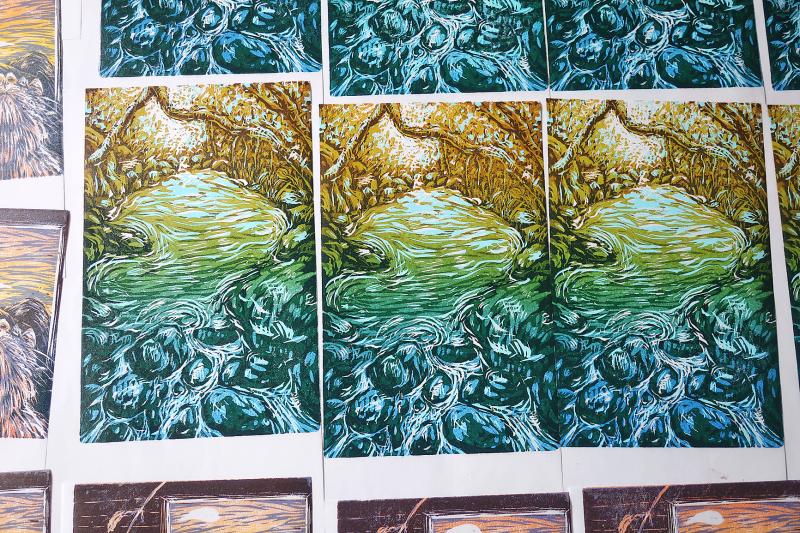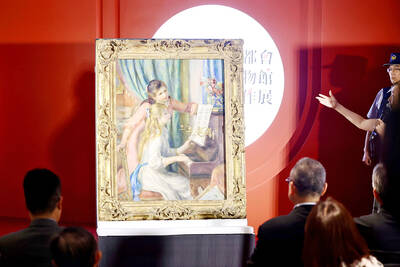A: So how is this color print made? I thought all printing was monochromatic.
B: This is relief printing, using a technique called reduction printmaking, which entails having one plate, engraving it, printing it, and then engraving it some more.
A: So it’s like a really big rubber stamp, carving it, charging it with ink and stamping it, and then carving another part, before putting an ink of a different color on it?

Photo: Tania Chou, Taipei Times 照片:台北時報周姲醇
B: That’s right. And relief printing is like “yang” engraving, while intaglio printing is like “yin” printing.
A: So reduction printmaking is an irreversible process: once you’ve carved away a part, it’s gone, and you can’t print it again.
B: Actually, all printing is an irreversible process, because the plate will get worn, and each time you print it, the engraving will become fainter. Even though you can print more than one copy, there is a limit to the number of copies you can make.
A: 這彩色的版畫是怎麼做出來的啊?我還以為版畫只有單色的。
B: 這是凸版畫,用的技巧叫做「單版複刻」,就是用同樣一個版,刻一些,印一些,再繼續刻。
A: 是不是就像面積很大的橡皮印章,刻掉一些,再沾印泥印,然後再刻一部分,再沾不同顏色的印泥?
B: 說得好!而且凸版畫就像印章的陽刻,凹版畫就是陰刻。
A: 那這樣「單版複刻」就是不可逆的過程,刻掉的部分沒了就是沒了,不能重印。
B: 其實印版畫都是不可逆的過程,因為版會磨損,印到後來就會變得比較模糊。所以雖然說版畫可以印不只一張,但數量是有限的。
(Translated by Paul Cooper, Taipei Times/台北時報林俐凱)
Audio recordings for Speak Up! dialogues will be suspended until further notice due to the pandemic.

William I of Prussia, a passionate painter, often autographed his works with “tormentis pinxit” — “painted in pain” — as a nod to his struggles with gout. Other historical figures like King Henry VIII of England and Benjamin Franklin also suffered from this “disease of kings,” which was common among people indulging in luxurious diets. Gout is primarily caused by high levels of uric acid in the body. Uric acid forms as the body breaks down purines, which are found in foods like red meat and seafood. Normally, the kidneys filter out uric acid. However, if the body produces

A: The National Palace Museum (NPM) has launched an exhibition, titled “From Impressionism to Early Modernism.” There are 81 masterpieces from the Metropolitan Museum of Art on display now. B: The exhibit, held to celebrate the NPM’s centennial, must be so spectacular. A: It includes artworks by 38 artists, such as Renoir, van Gogh, Cezanne, Matisse and Gauguin. B: The Fubon Art Museum has also launched an exhibit featuring a number of artworks of Impressionism, including Monet’s “Water Lilies.” A: And the New Taipei City Art Museum just had its grand opening, so there are even more exhibitions

A: What exhibitions are you going to see this summer? B: The 100% Doraemon & Friends exhibit is set to open on June 28. A: The news says there will be a 12-meter-tall giant Doraemon model at the Huashan 1914 Creative Park. B: The One Piece Carnival will set sail on the same day. A: And the D’festa Taipei 2025 – featuring exclusive content from K-pop supergroups such as BTS, NCT and Twice – is also set to begin next Friday. Isn’t that cool? A: 今年夏天還有什麼展覽可看啊? B: 「100%哆啦A夢 & Friends特展」即將在6月28日開幕。 A: 新聞說在華山1914文創園區會場,還有12米高的巨型哆啦A夢呢! B: 航海王「One Piece歡樂派對嘉年華」也將在同日啟航。 A:

The new generation born between 2025 and 2039 has been officially named “Generation Beta,” or simply “Gen Beta.” This generation will be the first to experience a world where artificial intelligence (AI) plays a key role in daily life. Generations are defined by shared cultural, social and historical experiences within a specific time frame. These experiences, often influenced by significant events and technological advancements, shape the values, attitudes and behaviors of each generation. The concept of generations helps us understand how different age groups interact with their environment and contribute to societal changes over time. The previous generational transition from Gen